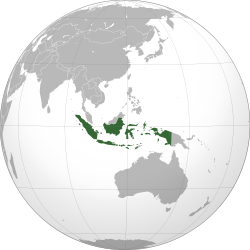The Indonesian Navy recently received its second locally-made fast attack craft with a plan to procure 14 units until 2014. This is part and parcel of its plan to have a ‘balanced’ fleet capable of performing wide-ranging naval tasks.
source:
SOUTHEAST ASIAN navies have been developing their ‘asymmetric capabilities,’ judging by their recent procurements. These range from submarines and mine warfare vessels to fast attack craft (FAC) armed with advanced anti-ship cruise missiles (ASCM).
Indonesia, too, is investing in these assets. Having recently secured a deal for three Type-209 Chang Bogo submarines from South Korea, Jakarta now plans to acquire 14 new FAC by 2014. This plan, however, should not obscure Jakarta’s intention to have a ‘balanced’ fleet to perform wide-ranging naval tasks.
Indigenous Fast Attack Craft

Indonesia
On 17 February 2012, the Indonesian Navy (TNI-AL) received its second locally-made KCR-40 FAC, KRI Kujang, after commissioning its first, KRI Clurit, in April 2011. Assistant for Planning for The Navy Chief of Staff, Rear Admiral Sumartono, said the boats would be deployed in the western part of Indonesia and North Sulawesi. They further augment TNI-AL’s fleet of FAC which currently numbers around 18 boats (4 Todak-class, 4 Kakap-class, 4 Singa-class, 4 Mandau-class, and 2 Selawaku (ex-Waspada)-class).
The FAC’s asymmetric leverage will also increase when they are fitted with ASCM, which Indonesia is also trying to develop. In addition, the Navy has ordered four 130-tonne trimarans from a local shipyard, with four anti-ship missile launchers in each hull, to be delivered by 2014.
Indonesia is also developing its indigenous naval missile technology to reduce dependence on foreign suppliers, and increase the FAC lethality. In March 2011, Indonesia and China signed a Memorandum of Understanding (MoU) which paved the way for closer defence cooperation, including joint missile production. Indonesia has acquired and tested a substantial number of Chinese C-802 missiles and installed them aboard Todak-class FAC and Ahmad Yani-class frigates. Regarded as more lethal than the C-802, Indonesia now aims for C-705 and has become its first overseas customer.
With a range of 75-170 km and smaller than the C-802, the C-705 is appropriately fitted for the smaller KCR-40 FAC. Based on the MoU, Indonesia would build a plant to manufacture the C-705, although this is not only related to the FAC project.
In addition, it recently bought an undisclosed number of Russian SS-N-26 ‘Yakhont’ supersonic anti-ship missiles for US$1.2 million apiece to replace Harpoon missiles on its frigates. In April 2011, the Yakhont was successfully tested and destroyed a designated target over 250 kilometres away. Jakarta also aims to manufacture 1,000 RHan 122 indigenous short-range ship borne missiles starting from 2014.
The FAC and anti-ship missiles will further bolster Indonesia’s sea denial capabilities. Together with naval mines and submarines, the FAC will support the TNI-AL’s Archipelagic Sea Defence Strategy (Strategi Pertahanan Laut Nusantara, SPLN), which seeks to deny the enemy fleet access to Indonesia’s archipelagic waters. Operationally, they are suitable for Indonesia’s complex maritime geography, with many gulfs, bays, estuaries, coves, and islets scattered across the archipelagic landscape.
This operating environment will also enable easier force dispersion and concealment when deployed against a larger adversary fleet. They will be effective to patrol maritime choke-points, such as the Malacca, Singapore, Sunda, and Lombok-Makassar Straits; and disputed waters in Sulawesi Sea. Costing over Rp. 73 billion (approx. US$8 million) each, the KCR-40 FAC provide a cost-effective means for the TNI-AL to, on one hand, increase its presence in the strategically vital, but criminally-prone, maritime areas, as well as maintain its naval warfighting orientation, on the other.
A ‘Balanced’ Fleet
Although the FAC might be sufficient to maintain sea denial in Indonesia’s narrow seas and archipelagic waters, they are certainly not a leverage Jakarta can exploit to expand its maritime interests. Large and versatile naval platforms, like frigates and destroyers, are still largely relevant for Indonesia for the following reasons.
Firstly, sandwiched between the Indian Ocean and Western Pacific, Indonesia’s three designated archipelagic sea lanes (ASLs) are the linkages of South and East Asian maritime economies. Being a coastal state, Indonesia has a responsibility to ensure that its ASLs are safe, secure, and open for global shipping.
While welcoming the rise of regional powers, particularly India and China, Indonesia is also very concerned with their naval developments. Indonesian waters are where Indian and Chinese naval expansions meet. Misunderstanding and miscalculation between them in these waters will inevitably generate adverse consequences for Indonesia’s maritime and national security.
Secondly, as a net oil importer since 2004, Indonesia’s energy security hinges on an uninterrupted supply of oil from the Middle East. Growing seaborne trade with South and East Asia further raises the stake of having a secure regional maritime environment, including and especially, the South China Sea. Indonesia is now respectively the world’s third and second-largest exporter of liquefied natural gas (LNG) and coal, bound mainly for China, India, Japan, South Korea and Singapore. This should make Indonesian defence and naval planners start thinking about having an externally-oriented TNI-AL.
Thirdly, with over five million migrant workers overseas, some of them currently residing in volatile regions like the Middle East; Indonesia must begin to seriously make naval non-combatant evacuation operations (NEOs) a priority for the TNI-AL. This also includes active promotion of good order at sea in places beyond its horizons, like participating in multinational counter-piracy operations in the Gulf of Aden.
For these reasons, the FAC are unlikely to become the backbone of TNI-AL’s force posture. Rather, this is only part of Jakarta’s efforts to have a ‘balanced’ fleet capable of carrying out various naval tasks, ranging from maritime anti-crime patrols to coastal defence.



0 comments:
Post a Comment